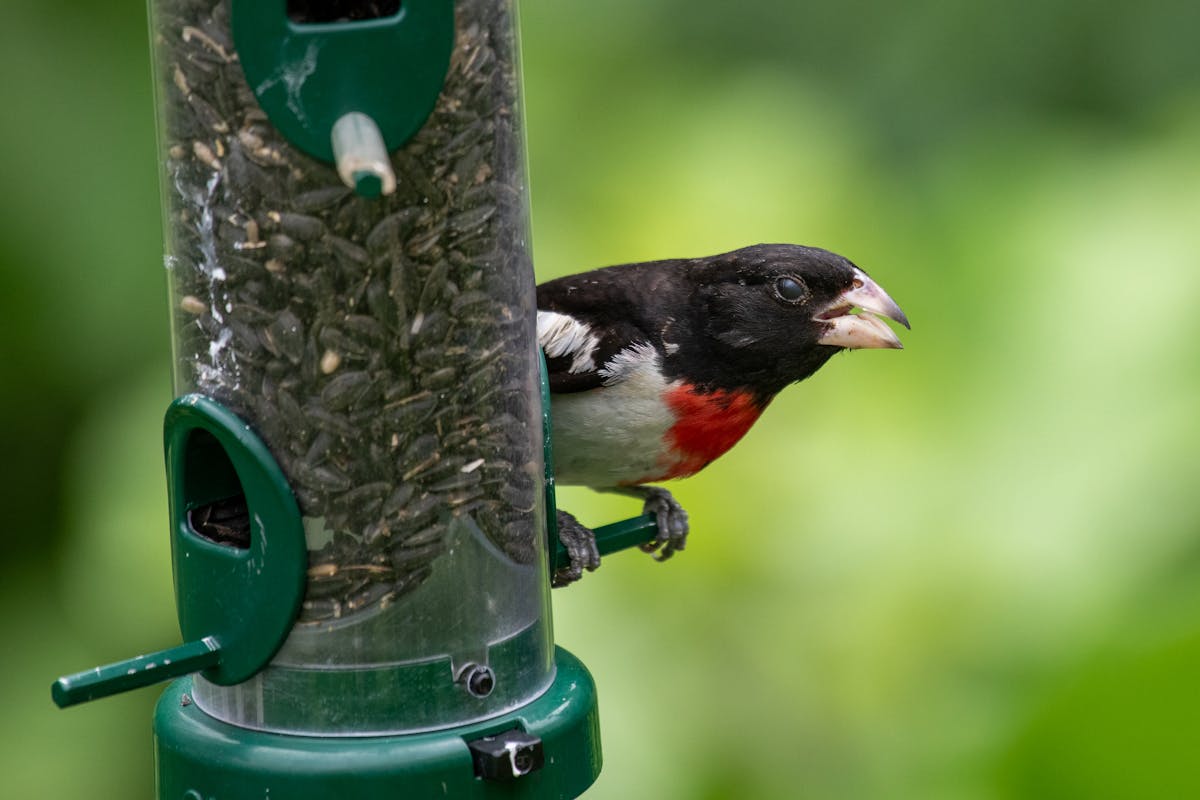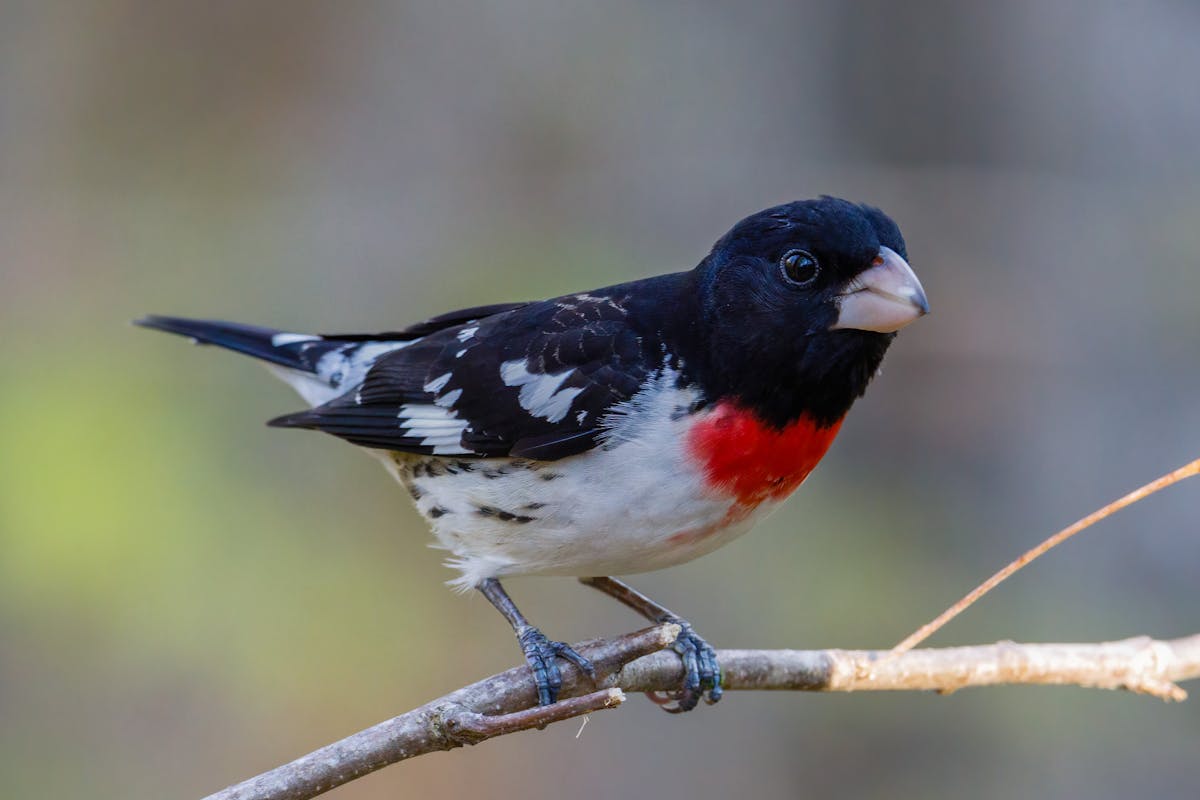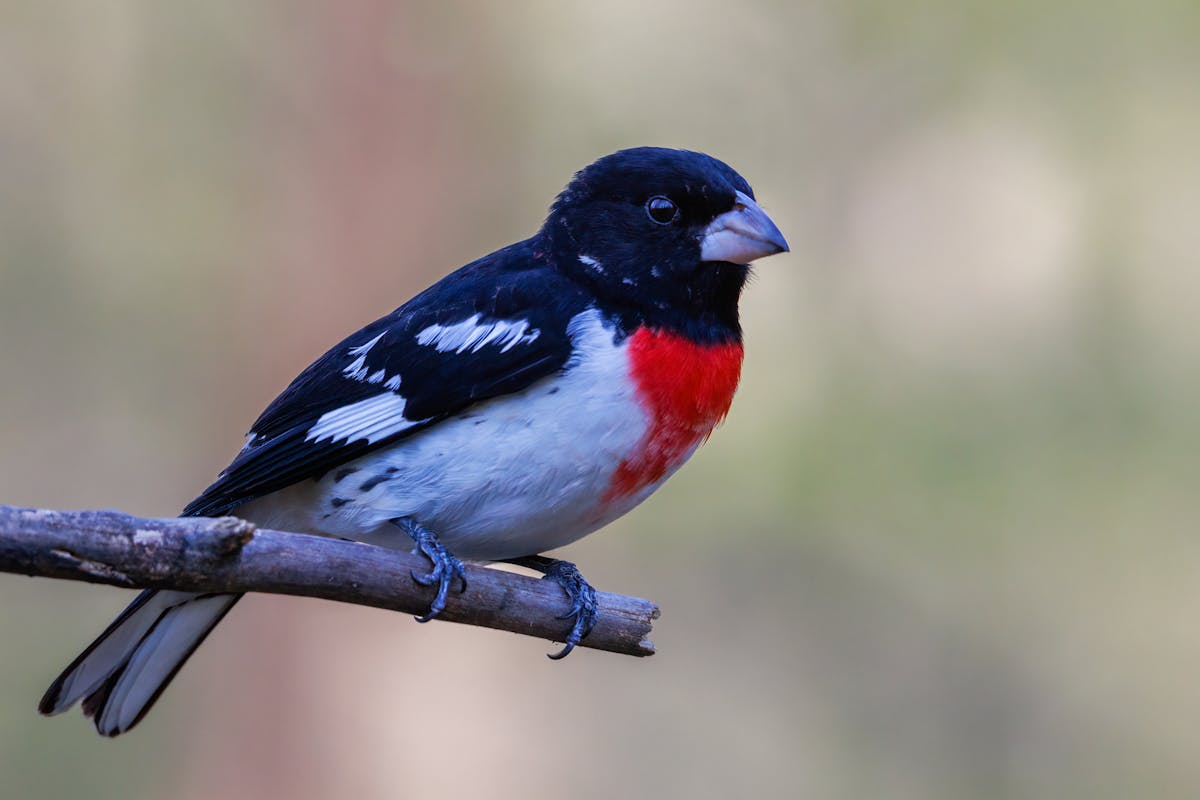
Rose-Breasted Grosbeak Introduction
The Rose-breasted Grosbeak (Pheucticus ludovicianus) is a large bird in the cardinal family. It eats seeds and is famous for its beautiful colors. Males have black heads and backs, white wings, and a bright rose patch on their white breast. They mainly live in eastern North America during breeding season. Then, they migrate to tropical America for winter. With its bright colors and sweet song, this bird attracts many bird lovers and others into the field. The rose-breasted grosbeak is part of the Cardinalidae family. This family also includes other colorful birds, like cardinals and buntings. These birds are not only colorful but also vital to their communities. They help by consuming seeds and insects.
In Europe, this bird often lives in deciduous forests and along wood edges. You can also find it in gardens, especially during the breeding season. The male is everything anyone could want—black, white, and rose—but what can we say about the female? She is brown and streaked delicately, though in her simple yet quite majestic form. In this article, we will discuss everything you need to know about the rose-breasted grosbeak bird.
Rose Breasted Grosbeak Facts
The rose-breasted grosbeak is a bird known for its unique traits. These include both its body features and its behavior. More details of lifespan/bird beak type, feather type, Size and Wing span, Call and Color type are as under.
Life Span:
In the wild, rose-breasted grosbeaks typically survive only about 7-8 years, though some have been known to survive for 12 years or more. Their resilience depends on habitat quality, food availability, and predation.
Bird Beak Type:
The beak of a rose-breasted grosbeak is a large, specialized feature used for its diet. It has a short, thick, conical beak that cracks seeds and nuts. These foods are a big part of its diet. The bird also has a clear plan for losing weight. This beak allows the bird to snag and slurp bugs, making it an adaptable feeder.
Feather Type:
The rose-breasted grosbeak’s soft, thick feathers offer insulation and assist with flight. Adult males stand out with their bright colors. They have a rose-purple patch on their breast. Their wings and back show black and white feathers. In contrast, females are brown banded with some stripes that can be used to provide better camouflage.
Size:
The bird measures approximately 7- 8 inches, or 18- 21cm, long, being short and stocky, and quite large-billed. During its annual migration, it can fly long distances.
Wing Span:
Wingspan: 28–33 cm (11–13 in) for the rose-breasted grosbeak. These broad wings allow for powerful and steady flight. This is important for the long migrations that Common Starlings make.
Call:
The rose-breasted grosbeak has a beautiful, melodic song. It’s often said to be a sweeter version of the American robin’s, but I think we can skip the “sweeter” part. The male’s song, a series of melodious whistled syllables, draws companions and secures territory. Both sexes also give a certain “chip” name in flight.
Color Type:
The male rose-breasted grosbeak is usually easy to spot. It has black upperparts, white underparts, and a lovely rose-pink patch on its breast. The female may not be as colorful, but she is just as beautiful. She has brown, streaked plumage that helps her blend into her surroundings, especially while nesting.
What Do Rose Breasted Grosbeaks Feed On
It is the common question from the bird loversWhat Does Rose Breasted Grosbeak Eat? Rose breasted grosbeak diet is seasonal-dependent as well as availability of meals. These birds consume a combination of seeds, culmination, and insects. In summer, they focus on insects. This includes beetles, caterpillars, and spiders. These insects are rich in protein, which helps in breeding and raising young. They particularly enjoy eating spruce budworm larvae so they are useful in controlling pests at wooded areas.
Feeding Habits:
The rose-breasted grosbeak has a diverse diet, which is made up of seeds and culmination during the non-breeding time of year. They are considered the ultimate going to bird feeders where they have the sunflower, safflower, or also peanuts. In the wild they are foragers, rooting among timber and shrub slot fed on berries, wild fruit and, now and then, little buds. Their powerful bill enables them to break open hard seeds easily. During migration, they eat nectar from flowers. This adds to their diet as they travel long distances.
Rose Breasted Grosbeak Range
The rose-breasted grosbeak is widely found in the Americas, both as a migrant and resident bird. During breeding season, these birds are usually seen in deciduous forests of Japan and central North America. They range from southern Canada to the northern United States. They pick habitats with extensive bushes and shrubs, making food and nesting sites plentiful.
In the cold, rose-breasted grosbeaks fly to Central and South America. Many of them spend the warm months in Mexico, Panama, and Colombia. One Crustacean: The Goliath Spider Crab lives mainly along Brazil’s eastern coast. Some can be found in northern South America, including Venezuela and Peru. They may be observed in various habitats during migration: gardens, shady border areas, or even tropical forests. This range shows how well the bird adapts to different habitats. It also highlights its need to find good conditions throughout the year.

Rose-Breasted Grosbeak Introduction
When Do Migrating Rose-Breasted Grosbeaks Go North
Rose-breasted grosbeaks usually start migrating north in early spring, around late April to early May. This timing enables them to arrive at their breeding areas as food sources such as bugs and new blooms become substantial. The migration is a long and tough journey. It covers hundreds, even thousands, of miles. Birds travel from their winter homes in Central and South America to their breeding grounds in North America.
These are some of the last migrants of the season. They time their moves to arrive after the danger of bloodless snaps is gone. This way, food is plentiful to support their breeding efforts. The males usually get there a few days to a week before the females to establish territories and begin singing to attract mates.
The rose-breasted grosbeak male and female
The rose-breasted grosbeak is well-known for its striking sexual dimorphism. The males and females look very different from each other.
Male:
The male rose-breasted grosbeak is easy to spot. He has striking black and white feathers, plus a bright rose-crimson patch on his breast. This colorful feature is why the species is named as it is. This shiny color is an important trait to attract a mate when breeding season approaches. Adult males also have a black head, wings with white patches and a black tail with white spots.
Female:
The female rose-breasted grosbeak looks quite different. She has brown, streaked feathers that help her blend in. This is especially useful during nesting time. The lady has a light stripe above the attention and a striped, buff-colored breast, providing concealment. It’s common to see different plumage in male and female hens. Males are often bright and colorful to attract females. In contrast, females have more muted colors to avoid predators and protect their nests.
Breeding & Predator Behavior Patterns of the Rose-Breasted Grosbeak
Courtship displays are many and mating behavior in rose-breasted grosbeaks is delightful. In the breeding season, the males sing to (1) establish territory and (2) attract women. That jangly, melodic line is fed regularly from a high snarl within the territory.
If a female enters a male’s territory, he might show off. He may puff out his chest, display his rose-red patch, and flutter his wings. If the female is receptive, she may also respond either by joining him in a duet or by engaging in mutual preening. Monogamous pairs form strong bonds that last during the breeding season. The male helps build the nest and lifts the juvenile, a less frequent habit in several distinct hen species.
Rose-Breasted Grosbeak Nests & Eggs
The nesting behavior of the rose-breasted grosbeak is key to their breeding success.
Rose-Breasted Grosbeaks nest by building their gouge nests in the forks of bushes. They typically choose spots 4 to 20 feet above the ground. The nests are weak structures of twigs, grasses, and leaves. Both the male and female help the nest, but the female does most of the work. Nests are often made in thorny bushes or shrubs. Their thick leaves help protect against predators.
Rose-Breasted Grosbeak Nesting:
When the nest is finished, the female lays a clutch of 3-5 pale blue or greenish eggs with brown spotting. These eggs incubate for about 12-14 days. During this time, the male sometimes takes over for the female. After the eggs hatch, both parents feed their chicks a diet rich in bugs. This helps the chicks grow quickly. The chicks fledge about nine to 12 days after hatching. They still need their mother and father for food and protection for several weeks.
Juvenile Rose-breasted Grosbeak
Juvenile rose-breasted grosbeaks are brown and streaked, similar to females. However, they lack the bright breast markings. This skill lets them blend in. It keeps them safe from predators as they learn to survive. Young birds are usually helped by their parents, who teach them to find food and understand their surroundings. Juveniles molt into adult plumage as they grow. Some males show their rose-pink patches, which serve a purpose, as they age.
Juveniles also practice writing songs during this time. Their first attempts often depend less on songs by adult males. By their first breeding season, mate-males can have all the colors and songs needed to claim their territories and attract females.

Rose-Breasted Grosbeak Introduction
How to Attract Rose-Breasted Grosbeaks
If you want to add these beautiful beaked birds to your garden, hosting or visiting can be a fun chance. They are affected by things like the abundance of food sources, water, and nesting spots nearby.
Food:
Attracting rose-breasted grosbeaks is another way to get them in your yard is to feed them their favorite foods. Sunflower seeds are their top food choice. You can offer them in platform or tube feeders that have large wing fields. These birds also appreciate natural foods, such as safflower seeds, peanuts, and suet. Growing native fruit trees and shrubs, like serviceberries, dogwoods, and elderberries, is good. But there are even better options.
Water:
As mentioned previously, fresh water should also be offered, specifically as a birdbath. In summer, birds eat insects and fruits, drink from water fountains and basins, take water baths and the like.
Nesting Sites:
Planting many bushes and shrubs in your yard helps attract rose-breasted grosbeaks. They build their nests in areas of dense foliage far from predators. Providing nesting materials like small twigs and dried grasses can help attract birds to your garden.
Avoid Pesticides:
Rose-breasted grosbeaks eat many bugs, especially when they breed. So, it’s important to keep your lawn free of pesticides. Healthy, insect-rich environments will draw them in.
Conclusion
The rose-breasted grosbeak is a fascinating bird. People admire it for its bright colors, lovely song, and unique behaviors. Based on their unique traits, passion, breeding habits, and nesting preferences, it’s easy to enjoy these birds. You can share in the joy of attracting and feeding them right in your yard. The rose-breasted grosbeak shows off the beauty of outdoor birds. It’s a great example for anyone curious about nature.








